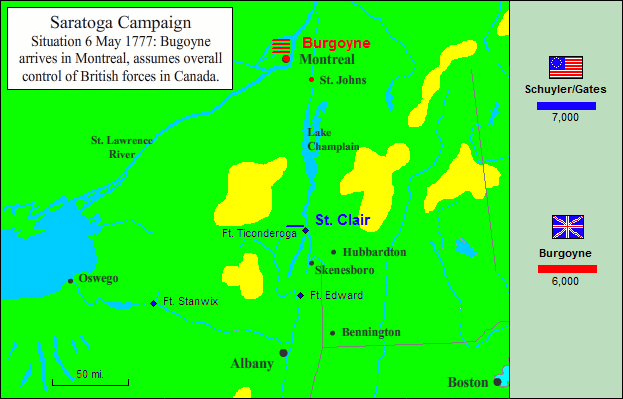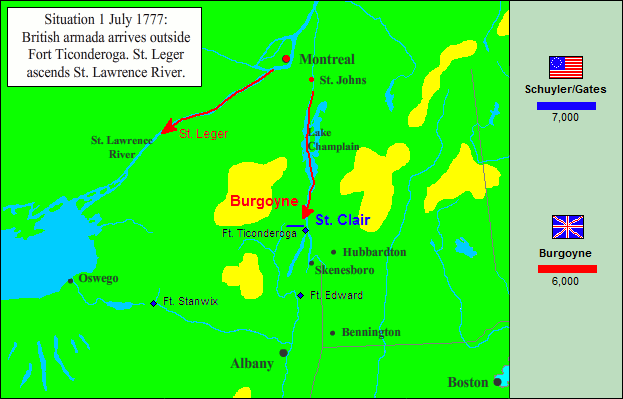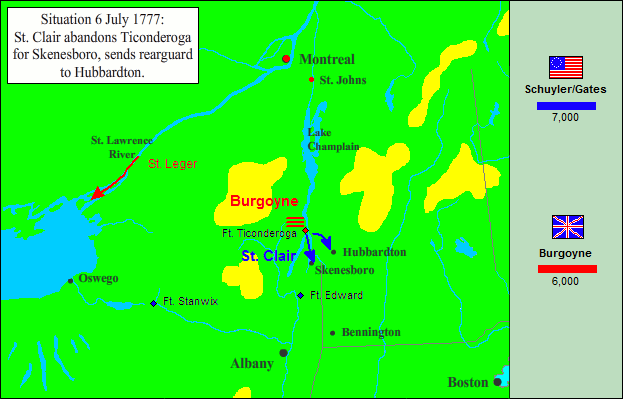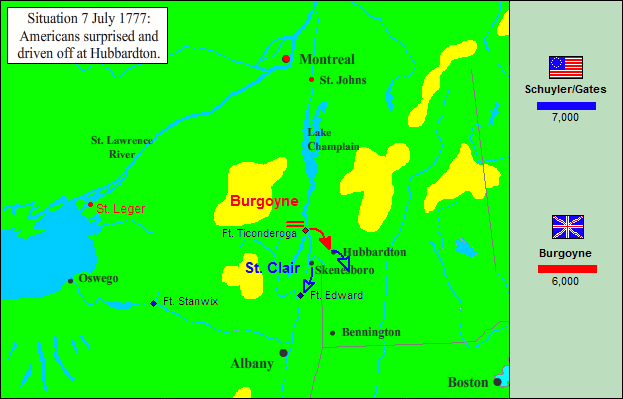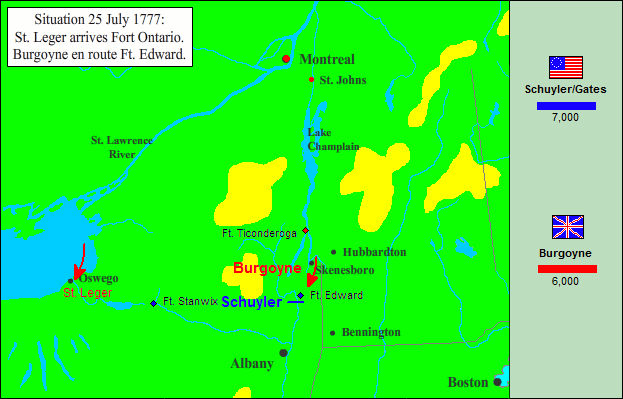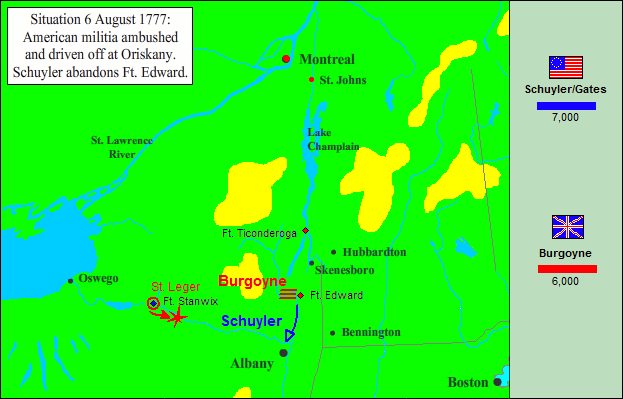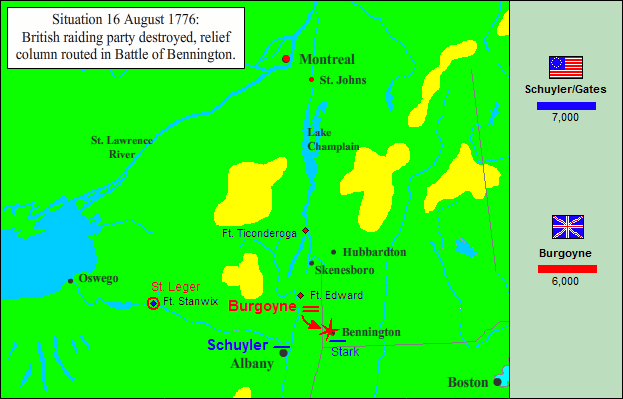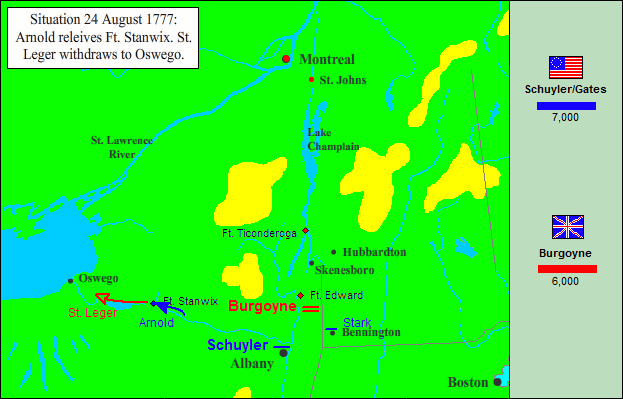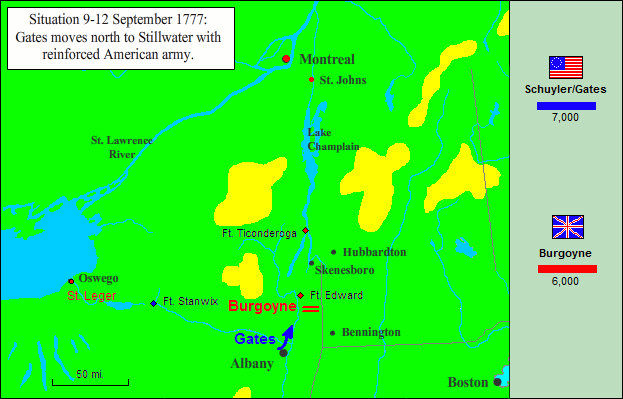Saratoga
…a country unpeopled and almost unknown in the last war, now abounds in the most active and rebellious race on the continent, and hangs like a gathering storm upon my left.
–John Burgoyne
As Washington’s army went into its miserable winter camps in and around Morristown, New Jersey, the Patriot faithful had some cause for gratitude: they had survived the disastrous summer of 1776. Although on at least three occasions the army had come within a whisper of destruction, the British had never driven home the decisive blow. Whether its survival was due to Patriot resilience, British lassitude or the designs of a providential God, the army was still in the field, camped on the slopes of Thimble Mountain, with an opportunity to catch their breath, regroup, refit, and train. In far-off London, however, General John Burgoyne was quite sure he knew how to crush this rabble and bring the rebellion to a close before the year was out, and was busy politicking the ministry for an independent command with which to do it. In a paper he called “Thoughts for Conducting the War from the Side of Canada,” he laid out a plan requiring the coordination of three separate commands. If Burgoyne had been more reflective than ambitious, he might have remembered Sir Edmund Burke’s final appeal for reconciliation, in which he put before his Tory opponents a hard-edged practical consideration: “Three thousand miles of ocean lie between you and [the Americans]. No contrivance can prevent the effect of this distance in weakening government. Seas roll, and months pass, between the order and the execution; and the want of a speedy explanation of a single point is enough to defeat the whole system.” Burke could see that British arms would face three antagonists: the broad, stormy Atlantic, the vast reaches of the American wilderness, and a determined and increasingly capable enemy. Burgoyne, however, was never one to take counsel of fear–his own or anyone else’s. He was quite sure that destiny beckoned and was willing to bet on it. Indeed, in the fashionable Brooks’ Club in London he bet Charles James Fox, a champion of the Whig cause, fifty guineas that he would “be home victorious from America by Christmas Day.” The British, then as now, are a wagering people, and not everyone was convinced that the smart money was on Burgoyne. Meanwhile, across the English Channel, the French likewise were about to take a sporting interest in Britain’s colonial war. In Paris, Doctor Franklin would soon persuade King Louis XVI to place a more substantial but thus far secret wager on the American cause: two million livres.
Thus, the destiny of two great European empires and an American republic as yet unborn would turn in large part on the campaign of the florid and flamboyant John Burgoyne. On the map, his three-pronged plan looked sensible enough. In it, Burgoyne would do the heavy lifting with a large force comprised of his own Regulars and German mercenaries. Ascending the St. Lawrence River as far as the Richelieu, he would sail south across the length of Lake Champlain, seize dilapidated Fort Ticonderoga, then push overland to the upper Hudson. From there it was a short march to Albany and glory. Meanwhile, a second column would converge on Albany from the west. Lieutenant Colonel Barry St. Leger would sail as far as the British base at Fort Oswego on the south shore of Lake Ontario, from which place his mixed force of British Regulars, Germans, Tories, and Native American allies would march eastward to the upper Mohawk River and follow that stream to the Hudson and Albany. The third prong of the campaign seems to have occurred to Burgoyne almost as an afterthought: while he and St. Leger closed on Albany from the west and north, Sir William Howe, presumably with the bulk of his army and the support of the navy, would drive up the Hudson. Together this formidable host would crush the Americans in their northern outpost. In Burgoyne’s imaginings, it mattered little what Washington to the south did while the three British columns converged on Albany. If he relinquished his hold on New Jersey and marched north to join the resistance, he was more than welcome to join his comrades in destruction. If he remained where he was, the four New England provinces would be thoroughly isolated. Though he was by no means forthcoming about the details of the region’s actual conquest, it was unthinkable that the Americans could lose the men and materiel of New England and still sustain the rebellion.
King George in particular was taken with the idea. Any plan that proposed the isolation and conquest of New England, the birthplace of rebellion in America, was attractive to him, regardless of its vagueness. And any plan that won the approbation of the king was likely to win a sympathetic hearing from Lord George Germain, his American secretary. By early March the ministry had officially approved Burgoyne’s northern campaign, and soon thereafter Gentleman Johnny, with his independent command in hand at last, was aboard HMS Appollo and sailing for Quebec. After a long winter of political infighting, he was happy to leave behind the rooms of state and lead an army in the field. But failures in the rooms of state were following in his wake. They flowed from one office chiefly, that of Lord George Germain, who was responsible for directing and coordinating a military enterprise that stretched from the St. Lawrence River in Canada to the St. Mary’s River on the Florida border. It was an immense responsibility, to be sure, and one might suppose that the first thing he would do would be to inform Sir William Howe, his supreme commander in America, of the new operational plans dealing with his northern department. Astonishingly, however, Germain wrote Howe eight times in the spring of 1777 and never once apprised him of Burgoyne’s mission in the north country. The most explicit information Howe would receive from Germain was a copy of the letter he sent to Sir Guy Carleton. This told Howe only that Burgoyne would lead an invasion south. In it there was no word of the strategic purpose of the campaign nor a single syllable of any responsibility on his part to cooperate with it.
Germain’s profound silence on the intentions of two substantial British armies in the north is even more astonishing in light of what he knew about Howe’s own intentions. Howe wrote on 2 April that he had finally resolved on a southern campaign, to sail out of New York with the bulk of his forces and operate against Philadelphia from the mouth of the Delaware. With luck he could bring Washington to battle and win a decisive victory; failing that, he would seize the Rebel capital and effectively take Delaware and eastern Pennsylvania out of the rebellion. These plans Germain approved with all expressions of confidence. Perhaps he had forgotten Burgoyne’s generous offer to place himself under Sir William’s command once Howe reached Albany; perhaps he believed absolutely in Burgoyne’s aggressive dash and his ability to carry the campaign to a brilliant success; perhaps he was simply unwilling to press Howe on this matter since Sir William was after all among the king’s favorites and a proven soldier. What Burgoyne realistically expected is hard to say. He was a constant consultant to his own ambitions; he might at least have imagined that for Howe the paths of glory did not necessarily lead to Albany. In any case, when campaigning season arrived, Burgoyne set off for Ticonderoga while Sir William sailed for Philadelphia far to the south. Germain seems to have believed that Howe could smash Washington, capture Philadelphia, and then turn on his heel and march to a juncture with Burgoyne. Neither Germain nor anyone else in the high command in London appeared to have a real sense of just how far it is, not as the crow flies but as a heavily laden man marches, from Brandywine Creek in northernmost Delaware, to the Batten Kill River opposite Saratoga. As Sir John Fortescue, historian of the British army, later put it with crisp simplicity: “Never was there a finer example of the art of organizing disaster.”
Disaster was no doubt the furthest thought from the mind of John Burgoyne as the Appollo landed him at Quebec on 6 May. During his first entry into the American conflict at Boston in ’75 he had crowed from the deck of the Cerberus that all the British army lacked was “elbowroom” to go to work with a will. Now he led an army of his own, but it is worth noting that he had won his new command in London, not on the field of battle. Meanwhile, the officer he would supersede in this new command, Sir Guy Carleton, had successfully defended Quebec against both a vicious winter and a desperate American attack. Whatever Carleton might have thought of his own deserving in this instance, he received Burgoyne cordially and handed over to him the required invasion force. It was a real army by this time, not the ragtag Regulars and irregulars with which he had saved Quebec, but they were now the instrument of John Burgoyne. The force was a little more than 8,000 in sum: about 4,000 British Regulars, some 3,000 Germans, mostly Brunswickers, 650 Tories, and 400 Iroquois Indians. Artillery too there was in abundance, 138 howitzers and guns, and Burgoyne decided that 42 of these would follow his infantry south. This provision must have seemed prudent to the general, who was prepared to blast any determined resistance flat, but it would have been likewise prudent to note that he had more artillerymen to handle his guns than horses to haul them. If he was short of horseflesh, however, he did not lack capable subordinates. He was seconded by a seasoned major general, William Phillips, and he had every reason to have confidence in an aggressive brigadier, Simon Fraser. The German column was commanded by Baron Friederich Adolph von Riedesel, a tested veteran of Germany’s endless dynastic wars. Gentleman Johnny was well pleased with his new command, and the men showed every sign of being pleased with their commander, who was known as “the soldier’s friend.” Mustering them at the mouth of the Richelieu, he pushed upstream, and in the final week of June, the vast flotilla of his invasion force started up the west shore of Lake Champlain. Off to the south somewhere were the Americans, in unknown numbers and fitness. Between his lead elements and the enemy lay plenty of elbowroom: the wide waters and the wild woods of the green, dark north country.
If Burgoyne had known of the confusion in the enemy’s camp just then, he would have been, if possible, even more radiantly confident. The northern department of the American theater was commanded by General Philip Schuyler, in peace a vastly wealthy Hudson River patroon and in war an able soldier. But he by no means enjoyed the warm confidence of his command, largely egalitarian Yankees who despised his aloof and aristocratic airs. To make division deeper, another general much more to their liking had been angling all winter for Schuyler’s job. General Horatio Gates was a plain-looking, plain-spoken Virginia tobacco planter. Though the son of an English servant, he had held a commission in the British army and had served with Braddock in the wilderness. He had the common touch but was not without cunning (as Washington was later to discover to his sorrow). His winter maneuvering in Congress got him what he wanted–command of the northern department–but just as Burgoyne was gathering his forces on the Richelieu, Congress swapped horses once more and returned the hated Schuyler to office. It was the sort of politicking that made the men in the ranks ask: who’s in charge here? In fact, the man in charge at the likeliest point of collision was Major General Arthur St. Clair, in command of the moldering pile that was Fort Ticonderoga. This Scottish-born veteran of the French and Indian War was, at forty, in the vigorous prime of life, and he had a sharp, purposeful intelligence. But there was very much to do here and precious little to do it with: barely 1,500 Continentals and two raw regiments of militia, 900 in all. Still, nothing daunted, St. Clair made a start at repairing the crumbling works of Fort Ti and extending his defenses across the narrow neck of Champlain to Mount Independence, a quarter-mile to the east. Though he was well aware of Burgoyne’s arrival in Canada, like most Americans he supposed that Burgoyne would then sail south by sea to join in Howe’s operations against Philadelphia. In any case, on the last day of June St. Clair looked out across his works and down the lake, where Burgoyne’s freshwater flotilla hove into view.
About three miles above Ticonderoga the invasion force clambered ashore, redcoats on the west bank, Riedesel’s Brunswickers on the east. As it happened, the western approach to Ticonderoga was fairly open woodland, but on the east shore, the Germans were making a very personal encounter with the wilds of America, slogging through the gelatinous muck around East Creek and swiping ineffectually at swarms of black flies, deer flies, mosquitos, and no-see-ums. As the two columns began to invest the fort, St. Clair feared an immediate assault, but Burgoyne entertained no such bloody business as that. (The costly assaults the Recoats had made before these walls back in the French and Indian War were part of the British army’s institutional memory.) Instead, Burgoyne’s axemen corduroyed the roads, and his gunners rolled their guns forward, ready to make a siege of it. But just then an enterprising young engineer, one Lieutenant Twiss, was about to hand Ticonderoga to Gentleman Johnny with hardly a shot fired in anger. Scouting south and west of the fort, his engineering eye saw that the 750-foot crest of Sugar Loaf (known to Americans as Mount Defiance) looked directly down into the American fort. The siting of British guns there would give the Americans two unattractive choices: run or perish in the rubble. Twiss was not the first to note this commanding crest. American engineers had urged the fort’s previous commanders to defend the hill, but each in his turn concluded that its slopes were too steep and heavily wooded for artillery. General William Phillips, himself an artilleryman, did not think so. Where a goat can go, he reasoned, a man can go, and where a man can go, he can drag a gun. And so Burgoyne’s axemen went to work once more; a rough road to the crest was cut and a field of fire cleared. By 5 July young Twiss had two twelve-pounders pointing their snouts down at Fort Ti.
St. Clair, like some of his subordinates, had for a time imagined that Burgoyne might hurl his army against their walls, in which case a desperate defense might have proved another Breed’s Hill for the British. But Burgoyne had never for a moment thought of obliging the defenders, and now the twelve-pounders peering down on the fort pushed St. Clair toward a painful decision: to sacrifice his honor, and evacuate his garrison in hot haste. After all, honor was one thing, but his 1,500 Continentals and 900 militiamen were worth infinitely more than Fort Ti’s crumbling walls. St. Clair understood that the fatal miscalculations at Forts Washington and Lee on the Hudson the previous summer must not be repeated here. The statesmen, however, were much slower to learn this lesson. When news of Fort Ti’s evacuation reached Congress, John Adams fumed in a letter to his wife, Abigail, that “we shall never defend a post until we shoot a general.” Still thinking of the struggle as “a war of posts,” it was hard for Adams to see that doing so would only lead to the loss of an indefensible fort and one of the cause’s most gifted generals. Few, it seemed, could appreciate that one of the greatest achievements of American arms thus far in the conflict had been Washington’s miraculous midnight escape from Howe’s grasp after the disaster on Long Island.
The politicians might fume all they liked at their leisure, but right now St. Clair faced the most demanding and challenging of all military operations: that of disengaging in the face of a superior enemy, retreating, and reforming on some more favorable ground. In the dead of night on 6 July, St. Clair loaded his sick and as much materiel as possible into bateaux and sent them south to Skenesboro. As his boats sculled southward, he marched his garrison across the floating bridge to Mount Independence, gathered up the defenders there, and the column, about two thousand strong now, started down the rutted track that led southeast to Hubbardton, then Castleton, and finally westward to Skenesboro. St. Clair might have made a clean getaway but for the vigilance of his enemies. Well before dawn, British pickets reported to Brigadier Simon Fraser that the American lines on the west bank of the lake were deserted. Not long after, roaring fires on Mount Independence revealed with perfect clarity that the whole American force was on the run. St. Clair’s orders had been quite clear: once the column was well down the road to Hubbardton, fire the barracks and supplies on Mount Independence and burn the floating bridge that joined it to Fort Ti. But in the dark confusion of a desperate retreat, the barracks were burned too soon and the bridge burned not at all.
Simon Fraser was not one to sit on his hands when opportunity called, and Burgoyne was only too pleased to send him in hot pursuit. Dawn was still two hours off when an advance corps of 850 grenadiers and light infantry stepped off into the eastern woods. The British were tough campaigners and Fraser was a driver, and drive he did through that hot, humid July day, from four in the morning to late that afternoon with hardly a halt. Though the pursuers did not overtake the American column, they easily outmarched their own reserve, the 1,200 Brunswickers under Riedesel who were hopelessly strung out along the woodland track. By three the next morning Fraser’s men were on the march again, and two hours later they made contact with St. Clair’s rearguard. It was not much of a collision. The Americans camped outside Hubbardton were New Hampshire men. All were exhausted, many were sick, and a few were quite drunk. They were overwhelmed in minutes, and those not scooped up as prisoners were legging it for Castleton. But behind them was another New Hampshire outfit under Colonel Seth Warner and the 11th Massachusetts under Colonel Ebenezer Francis. These settled in on a wooded slope to make a fight of it.
When Fraser shook out his battle lines and sent them up the hill, a savage struggle blew up on a half-mile front and the British advance was beaten back. Fraser, hot-blooded but cool-headed, struck again, trying to push the weight of his attack around the American left. Francis, equally cool, struck back also, attacking the British left. The battle whipsawed back and forth, but so stiff was American resistance on his front and so fierce the pressure on his left, that it was Fraser now who was in serious trouble. Salvation, however, was marching up the road in his left rear in the form of Riedesel’s vanguard with a rattle of drums and two hundred voices roaring out a Lutheran hymn. The jagers with their short rifles poured in behind Fraser’s embattled left and shored up the wavering line. On the American side, Colonel Francis was shot dead with a bullet through his breastbone, and with their commander down, the Massachusetts men fell back. When Warner’s men did likewise, the fighting sputtered out, a drawn battle, but it had been a near thing for the British. As his marched-out, fought-out men dropped into fitful sleep, Fraser reckoned his losses in this little rearguard affair: 50 dead, 134 wounded, roughly a fifth of his force. The Germans, in action only minutes, had one casualty for every ten men who went into the fight. Fraser’s honor may have been satisfied by holding the field, but he had paid a great deal in blood for a patch of scrubwood. The American losses were likewise severe: 41 dead, 91 wounded, and more than 300 captives (most of these invalids). Fraser and Riedesel broke off their pursuit, and the survivors slogged wearily on to join the Patriot column at Castleton. St. Clair continued his retreat unharried to Skenesboro and, after another sharp little rearguard fight at Fort Anne, reached Fort Edward on the east bank of the Hudson on 12 July. He had lost Ticonderoga but had saved his army, which still stood between Burgoyne and Albany. Meanwhile, Gentleman Johnny was savoring his conquest of Ticonderoga, or as he imagined it, the Gibraltar of the North.
And yet Burgoyne’s success was not all moonbeams. Though the British pursuit by land had been checked at some cost at Hubbardton, St. Clair’s army was in fact limping into crumbling Fort Edward bloodied and beaten. Equally encouraging, the British flotilla that followed the fleeing Americans up the lake had overtaken them at Skenesboro. Though most of the soldiery escaped overland, a small fleet of boats was sunk or captured, along with guns and vast stores of foodstuffs. General Schuyler did not put too fine a point on it when he wrote to Washington that the enemy was “flush with victory” and amply supplied; the Americans, by contrast, were “dispirited, naked… without camp equipage, with little ammunition and not a single cannon.” When the news of Fort Ti’s fall and the action at Hubbardton reached King George, he was beside himself with joy. Rushing into Queen Charlotte’s boudoir, he exulted, “I have beaten them all, I have beat all the Americans!” Many Americans did in fact think themselves beaten; some even grumbled darkly that they had been betrayed by St. Clair and Schuyler for British silver.
But the American cause was about to receive a gift richer than silver in the form of a command decision by John Burgoyne himself. When not enjoying the charms of an attractive mistress and fine champagne at Skenesboro, the general was busy working out the problem of how to dislodge the Americans from their ragged post at Fort Edward and get on to Albany. As far as his staff was concerned, the solution had already been laid out quite clearly in Burgoyne’s famous “Thoughts.” It was a simple matter of moving fleet and fighting men back to Fort Ti and crossing his boats to Lake George. While his sailors shifted his heavy guns and supplies (now in abundance) to the head of the lake, his marching columns would follow a fairly good road down the left bank. Holding Fort George as a base of supplies, he had an easy ten-mile march to the great western bend of the Hudson; then it was all downriver to Fort Edward and on to Albany. It was all abundantly clear; that is, to everybody but John Burgoyne, who had resolved instead to cut his way through the wilderness and march to Fort Edward overland. Thoughtful students of the war have had more than two centuries to weigh his motives, which will no doubt forever remain mysterious. Certainly Burgoyne’s own account two years later would do little to clarify the matter. “A retrograde motion”–that is back to Fort Ti–would, he argued, have been bad for morale. Then too it would have given the Rebels possession of Fort George on his flank, forcing him to a siege at that post and retarding his advance on Albany. Besides, he added, an overland route of some twenty miles would give his men an opportunity to improve their “wood service,” a euphemism given to the hard labor of hewing a road through the wilderness. Wood service his men would get with a vengeance, but there is no reason to think that it improved the morale of the men now committed to cutting a twenty-mile track through the forest primeval.
Even as Burgoyne’s men set about clearing a road from Fort Ticonderoga to Fort Edward, woodsmen were already at work in the forest south of them. These were a thousand Americans left behind by Schuyler, and they were making the woods ring. They dropped virgin timber across the narrow track, sent some forty bridges crashing into creeks and ravines, dammed up streams and created their own swamps to add to nature’s plenty; all of which obstacles would have to be cleared before Burgoyne’s ponderous train of guns and supplies could so much as turn a wheel. In fact, Burgoyne’s column was going nowhere at all just then, at least not until the grudging countryside could be scoured for more horses and oxen to haul the wagons. When the column finally did get in motion it was of an agonizing sort: endless, toilsome, sweaty days with nothing but dark forest behind and darker forest ahead. In the end, it was twenty-six days before Burgoyne’s van emerged from the forest and reached the ruin of Fort Edward–twenty-six days to cover twenty miles. He was on the Hudson at last, but even then Burgoyne was not ready to push on to Albany. His heaviest guns had gone by water to the head of Lake George and were still rumbling and creaking eastward over another wretched wilderness road to join him at Fort Edward. In the first week of August Burgoyne’s army went into camp in the meadows around the fort to wait for the guns. Their “wood service” had exhausted men and beasts, and supplies–in abundance just three weeks ago–were already running short. One other element was running short as well: time. The brief north country summer was slipping away. Albany was still a good stretch of hard marching to the south, and though Burgoyne did not know it, Schuyler and 4,500 armed Americans were already at Stillwater preparing to dispute the passage. Burgoyne’s star had begun to set, but he did not know that either.
Burgoyne was sure that he could not go forward until he could restore his supplies. Some of his officers thought that an advance corps might push on and secure a junction with St. Leger and Howe at Albany immediately. But Gentleman Johnny was casting his eye eastward, to the rich farm country of the Hampshire Grants (now Vermont). There was wheat, corn, and horseflesh in abundance. A swift raid into the countryside would return all he needed to resupply and remount his troops. Then too there was no telling how many Loyalists would be quick to answer the king’s call. (From beginning to end British generals dreamed of these mythical legions of Loyalists; they never appeared.) If Burgoyne believed that the king’s colors would inspire the loyal countryside, he made an exceedingly odd choice of the troops to conduct this raid: Riedesel’s Brunswickers who spoke no English. Worse yet, Riedesel’s dragoons and grenadiers were hardly the troops for a flying raid that seemed to call for light infantry and jagers. If the business ahead were not so bloody, the dragoons themselves would have made a comic picture, lumbering along in outlandishly heavy boots (twelve pounds to the pair!), heavy saber, short rifle. It was hardly marching kit. But off they marched on 11 August under the command of Lieutenant Colonel Friederich Baum, a column seven hundred strong, not quite 400 Germans, 300 Canadians, and a handful of Indians to spread panic before them. They were headed for Bennington, twenty-five miles to the east, but the enemy commander waiting to receive them was not at all given to panic.
Tall, spare Colonel John Stark had fought Indians in the last war and redcoats in this, and now he was angry at just about everyone, including the Continental Congress which had passed him over for promotion to brigadier general at the close of the previous year. With 1,500 militiamen at his back, he marched in high dudgeon on Bennington. Lieutenant Colonel Baum was no very skilled soldier, but he was smart enough to listen to the insistent urgings of panic. Aware of Americans massing on his line of march, he sent to Burgoyne for reinforcements and began to dig in on a rise of ground above the Walloomsac River just outside Bennington. Early on 16 August the whole of Stark’s force came crashing down on Baum’s men from every point of the compass. Baum’s outlying posts collapsed at the first shock. Some of these were so poorly posted that they were a half-mile from the main line, and few were in supporting distance of each other. However badly lead, Baum’s dragoons in the center put up a stiff resistance, and hard, bitter, close-quarters fighting roared on through the morning. Near noon the Germans ran out of cartridges and tried to cut their way through the circling Americans at sword point. It may have been at this moment that John Stark shouted his famous war cry: “Come, my lads! We must get them beaten; or tonight Molly Stark is a widow.” And the Germans were beaten, hundreds captured, hundreds more in flight.
Stark’s men were in mad pursuit of the fugitives when they ran headlong into Burgoyne’s relief column, 800 men, mostly Germans, under Lieutenant Colonel Heinrich Von Breymann. Having fought since first light, the New Hampshiremen now had a new battle blow up in their faces. The Germans had taken their sweet time in coming to Baum’s support, making barely half a mile an hour on the march, but now that they were on the field, they pitched into the fight with a determined will. For a time it was blow and counterblow with the Germans giving somewhat better than they got. Stark, however, was not only tough and resourceful, he had a further indispensable gift: he was lucky. As his own lines were beginning to buckle and break, they were supported by those of Seth Warner’s Continentals and some 200 Green Mountain Boys. When these reinforcements struck Breymann on both flanks, resistance collapsed. An orderly retreat became a rout, and Breymann’s survivors–about two-thirds of the original force–started for Burgoyne’s camps much faster than they had come. Not one had gotten within a mile of the hillside where Baum’s command had been virtually destroyed. They slogged into their old camp at Fort Edward the next day, mud-spattered and miserable, and Burgoyne rode out to meet them and tender his gratitude for “their very pretty little success.” Burgoyne may have been drinking when he made this gracious little speech. But the inescapable fact was that he had lost a thousand irreplaceable fighting men and gained exactly nothing–unless it was a dawning awareness of his danger. “The Hampshire Grants,” he wrote, “a country unpeopled and almost unknown in the last war, now abounds in the most active and rebellious race on the continent, and hangs like a gathering storm upon my left.”


